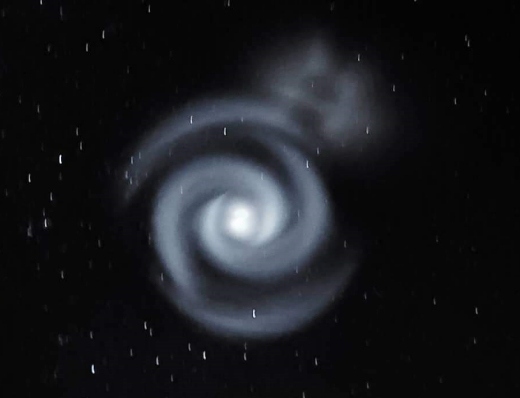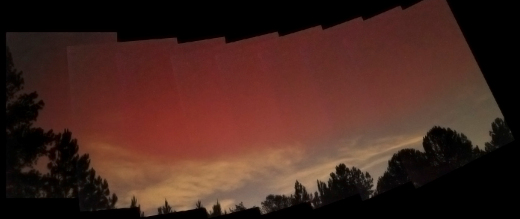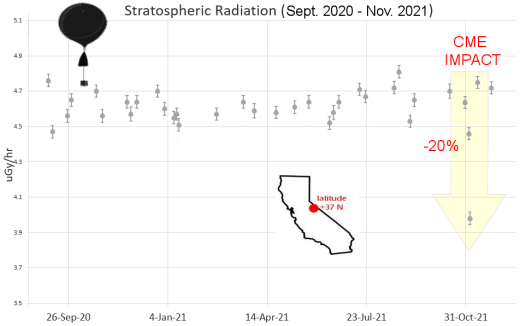Never miss another geomagnetic storm. Sign up for Space Weather Alerts and you'll receive a text message when magnetic storms erupt. Aurora your guides and professional astronomers use this service. You can, too! | | |
BIG SUNSPOT ALERT: Yesterday, sunspot AR3038 was big. Today, it's enormous. The fast-growing sunspot has doubled in size in only 24 hours: movie. AR3038 has an unstable 'beta-gamma' magnetic field that habors energy for M-class solar flares, and it is directly facing Earth. Solar flare alerts: SMS Text.
STRANGE THINGS IN THE SKY, COURTESY OF SPACEX: On Sunday morning, June 19th, SpaceX launched a Falcon 9 rocket from Cape Canaveral (0427 UT) carrying a Globalstar communications satellite. Within hours, people around the world started seeing strange things in the sky. First came the "smoke ring." Jerrod Wood video recorded it from central Illinois:
"I believe it shows the orbital insertion of the Globalstar FM15 satellite," says Wood.
He's right. Almost two hours after launch, the upper stage of the Falcon 9 rocket deployed the Globalstar satellite; the smoke ring Wood saw was the "puff" of separation. At the time, the rocket was more than 1100 km high, so people were able to see it across much of North America. Check out these images: from Arizona, Missouri, Iowa and California.
An hour after the smoke ring, things got really strange. Sky watchers in New Zealand saw this:

"It looked like a beautiful galaxy," says photographer Alasdair Burns of Twinkle Dark Sky Tours on Stewart Island. "It was a very slowly rotating spiral that started small and gradually expanded. Eventually it became so large and faint that it could no longer be seen. There were a group of us on our balcony watching it and none of us had ever seen anything like it."
This spiral was caused by the Falcon 9's upper stage venting leftover fuel just before deorbiting into the Pacific Ocean. The upper stage was probably spinning on its longest axis to stabilize flight orientation--hence the spiral shape. Similar spirals have been seen after previous Falcon 9 launches.
Finally, David Cortner of Rutherford College, North Carolina, saw something truly head-scratching. He calls it a "rocket powered aurora." This 8-frame mosaic shows a red band that appeared approximately 11 minutes after the Falcon 9's liftoff from Cape Canaveral:

"I went out to watch the midnight launch," says Cortner. "Here in western North Carolina, I was hoping for a faint, moonlit 'jellyfish'--the kind of display we see after many SpaceX launches." But that's not what happened.
"The rocket's trajectory was much higher than I expected," he continues. "It was almost 500 km high by the time it was due east of me, not 150-200 km like most SpaceX flights up the Atlantic coast. As a result, the rocket passed by unseen."
"Instead, I noticed this red glow spreading along the flight path a minute or two after the rocket's closest approach," he says. "It looked like the aurora borealis."
Could it have been auroras? Probably not. Low-latitude red auroras typically appear only during strong geomagnetic storms. At the time of the photo, however, global geomagnetic activity was low (Kp=3); there was no space weather event in progress.
There has been much discussion on the web about a covert payload hitchiking on this Falcon 9 rocket. Analysts believe that a clandestine satellite may have been released about 10.5 minutes after launch. This is strikingly similar to the time Cortner witnessed the red glow over North Carolina. Moreover, a photographer in Ohio may have witnessed the same thing.
We still do not know what produced this glow. Readers with good ideas are encouraged to share them.
Realtime Space Weather Photo Gallery
Free: Spaceweather.com Newsletter
"I LOVE YOU FOREVER" MOONSTONE PENDANT: Are you looking for a far-out gift? Consider the "I Love You Forever" Moonstone. This one hitched a ride to the stratosphere onboard a cosmic ray research ballooin on May 13, 2022:

You can have it for $162.95. The moonstone's sterling silver infinity wrap is inscribed with the words "I love you forever." It makes a great anniversary or birthday gift. The moonstone comes with a greeting card showing the pendant in flight, telling the story of its trip to the edge of space and back again.
Far Out Gifts: Earth to Sky Store
All sales support hands-on STEM education
Realtime Aurora Photo Gallery
Free: Spaceweather.com Newsletter
Realtime Noctilucent Cloud Photo Gallery
Free: Spaceweather.com Newsletter
Every night, a network of
NASA all-sky cameras scans the skies above the United States for meteoritic fireballs. Automated software maintained by NASA's Meteoroid Environment Office calculates their orbits, velocity, penetration depth in Earth's atmosphere and many other characteristics. Daily results are presented here on Spaceweather.com.
On June 20, 2022, the network reported 10 fireballs.
(9 sporadics, 1 Northern June Aquilid)

In this diagram of the inner solar system, all of the fireball orbits intersect at a single point--Earth. The orbits are color-coded by velocity, from slow (red) to fast (blue). [Larger image] [movies]
Potentially Hazardous Asteroids (
PHAs) are space rocks larger than approximately 100m that can come closer to Earth than 0.05 AU. None of the known PHAs is on a collision course with our planet, although astronomers are finding
new ones all the time.
On June 20, 2022 there were 2279 potentially hazardous asteroids.
 |
Recent & Upcoming Earth-asteroid encounters: | Asteroid | Date(UT) | Miss Distance | Velocity (km/s) | Diameter (m) |
| 2022 LO3 | 2022-Jun-15 | 1.8 LD | 11.6 | 16 |
| 2022 LC2 | 2022-Jun-15 | 10.1 LD | 10.2 | 29 |
| 2022 MC | 2022-Jun-17 | 5.4 LD | 14.8 | 62 |
| 2022 LA3 | 2022-Jun-18 | 7.4 LD | 7.2 | 22 |
| 2022 MB | 2022-Jun-19 | 16.5 LD | 7.5 | 53 |
| 2022 LX | 2022-Jun-22 | 10.4 LD | 10.1 | 35 |
| 2022 LS1 | 2022-Jun-23 | 18.9 LD | 9.9 | 35 |
| 2022 LB2 | 2022-Jun-25 | 5 LD | 8.3 | 23 |
| 2022 LV | 2022-Jun-25 | 2 LD | 3.6 | 22 |
| 2015 WP2 | 2022-Jun-26 | 18.5 LD | 11.4 | 3 |
| 2022 MD | 2022-Jun-26 | 14 LD | 8.3 | 53 |
| 2022 MF | 2022-Jul-02 | 14.8 LD | 12.1 | 37 |
| 2022 JE1 | 2022-Jul-03 | 8.6 LD | 5.6 | 74 |
| 2021 EL4 | 2022-Jul-05 | 19.8 LD | 9.5 | 25 |
| 2015 OQ21 | 2022-Jul-12 | 18.3 LD | 6.6 | 9 |
| 2022 LR1 | 2022-Jul-16 | 9.3 LD | 4.7 | 42 |
| 2022 KY4 | 2022-Jul-17 | 15.9 LD | 7.6 | 91 |
| 2021 OT | 2022-Jul-17 | 16.5 LD | 11.2 | 20 |
| 349068 | 2022-Jul-19 | 17.6 LD | 22.9 | 756 |
| 2017 RX2 | 2022-Jul-24 | 17.2 LD | 14.2 | 17 |
| 2016 CZ31 | 2022-Jul-29 | 7 LD | 15.6 | 129 |
| 531944 | 2022-Jul-30 | 18.2 LD | 5.9 | 192 |
| 2020 PP1 | 2022-Aug-01 | 13.1 LD | 3.7 | 17 |
| 2020 PN1 | 2022-Aug-03 | 9.7 LD | 4.6 | 29 |
| 2015 FF | 2022-Aug-12 | 11.2 LD | 9.2 | 17 |
Notes: LD means "Lunar Distance." 1 LD = 384,401 km, the distance between Earth and the Moon. 1 LD also equals 0.00256 AU. MAG is the visual magnitude of the asteroid on the date of closest approach. | | Cosmic Rays in the Atmosphere |
SPACE WEATHER BALLOON DATA: Almost once a week, Spaceweather.com and the students of Earth to Sky Calculus fly space weather balloons to the stratosphere over California. These balloons are equipped with sensors that detect secondary cosmic rays, a form of radiation from space that can penetrate all the way down to Earth's surface. Our monitoring program has been underway without interruption for 7 years, resulting in a unique dataset of in situ atmospheric measurements.
Latest results (Nov. 2021): Our balloons have just measured a sudden drop in atmospheric radiation. It happened during the strong geomagnetic storms of Nov. 3-4, 2021. Here are the data:

This is called a "Forbush decrease," named after American physicist Scott Forbush who studied cosmic rays in the early 20th century. It happens when a CME from the sun sweeps past Earth and literally pushes cosmic rays away from our planet. Radiation from deep space that would normally pepper Earth's upper atmosphere is briefly wiped out.
We have measured Forbush decreases before. For example, here's one from Sept. 2014. The Forbush Decrease of Nov. 3-4, 2021, was the deepest in the history of our 7-year atmospheric monitoring program. Radiation levels in the stratosphere over California dropped nearly 20%, more than doubling the previous record from our dataset.
En route to the stratosphere, our sensors also pass through aviation altitudes, so we can sample radiation where planes fly. This plot shows how the Forbush decrease was restricted to the stratosphere; it did not affect lower levels of the atmosphere:

The dose rates shown above are expressed as multiples of sea level. For instance, we see that boarding a plane that flies at 25,000 feet exposes passengers to dose rates ~10x higher than sea level. At 40,000 feet, the multiplier is closer to 50x. The higher you fly, the more radiation you will absorb.
.Who cares? Cosmic rays are a surprisingly "down to Earth" form of space weather. They can seed clouds, trigger lightning, and penetrate commercial airplanes. According to a study from the Harvard T.H. Chan school of public health, crews of aircraft have higher rates of cancer than the general population. The researchers listed cosmic rays, irregular sleep habits, and chemical contaminants as leading risk factors. Somewhat more controversial studies (#1, #2, #3, #4) link cosmic rays with cardiac arrhythmias and sudden cardiac death.
.Technical notes: The radiation sensors onboard our helium balloons detect X-rays and gamma-rays in the energy range 10 keV to 20 MeV. These energies span the range of medical X-ray machines and airport security scanners.
Data points in the first graph ("Stratospheric Radiation") correspond to the peak of the Regener-Pfotzer maximum, which lies about 67,000 feet above central California. When cosmic rays crash into Earth's atmosphere, they produce a spray of secondary particles that is most intense at the entrance to the stratosphere. Physicists Eric Regener and Georg Pfotzer discovered the maximum using balloons in the 1930s and it is what we are measuring today.
| | The official U.S. government space weather bureau |
| | The first place to look for information about sundogs, pillars, rainbows and related phenomena. |
| | Researchers call it a "Hubble for the sun." SDO is the most advanced solar observatory ever. |
| | 3D views of the sun from NASA's Solar and Terrestrial Relations Observatory |
| | Realtime and archival images of the Sun from SOHO. |
| | information about sunspots based on the latest NOAA/USAF Active Region Summary |
| | from the NOAA Space Environment Center |
| | fun to read, but should be taken with a grain of salt! Forecasts looking ahead more than a few days are often wrong. |
| | from the NOAA Space Environment Center |
| | the underlying science of space weather |
 | Going above and beyond to provide the best homes listings in the Comox real estate market to keep you up to date and informed |
 | BestCSGOGambling is the best site for everything related to CSGO gambling on the web |
 | To find reviews of new online casino sites in the UK try The Casino DB where there are hundreds of online casino reviews complete with bonuses and ratings. Alternatively, Online-Casinos.xyz is another massive directory of online casinos listing sites for the UK and Worldwide. Casinos that offer Rupees for bonuses are very generous to Indian players. Find the best online casinos in India at AllCasinos.in Looking for a new online casino? Try Casimpo the new site dedicated to making online casino simple, or check out the new Avenger Slots Casino and Ace Online Casino with over 500 online slots and casino games. |
 | One of the most popular casino games is the Book Of Dead Slot based on ancient Egyptian text, you can find all the casinos with spins at bookofdeadslotsites.com. |
 | When looking for casinos to play online when the weather is bad, you can try casino online trucchi for Italian games. If you are not from Finland you can try the Swedish page Svenska casino online to find suitable games, check out svenskacasinoonline.net. Always check your local laws before playing with real money. |
 | Looking for sports betting companies not registered on GamStop? CasinoGap has presented a list of sites not on GamStop available for UK players. Check and bet online! Would you like to bet at sites not using GamStop? Look at a list of NonStopCasino sites for online betting that aren't on GamStop. Top-rated bookmakers ever! |
| | These links help Spaceweather.com stay online. Thank you to our supporters! |
| | | | | | |

